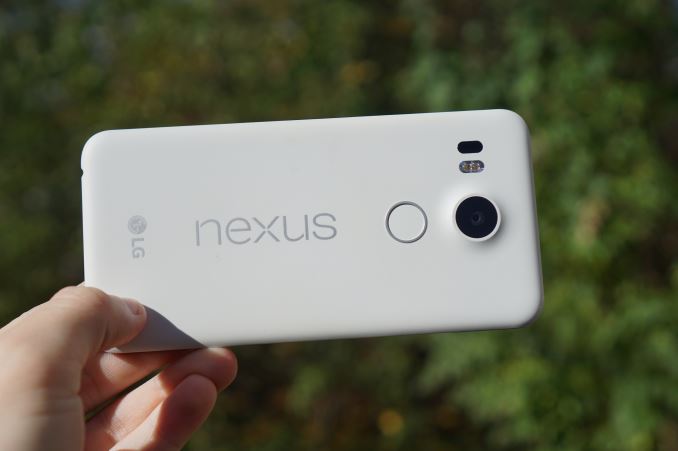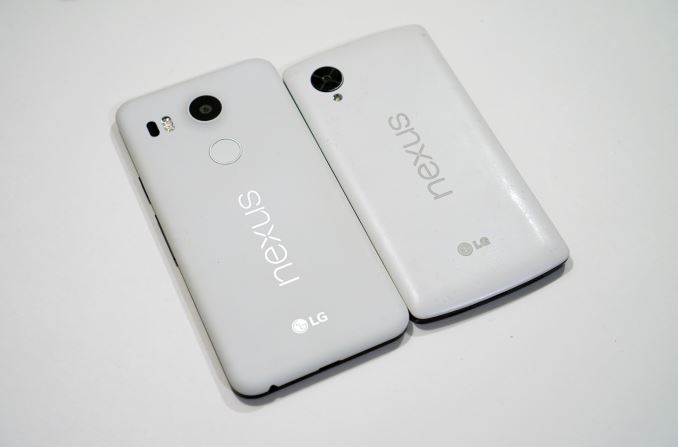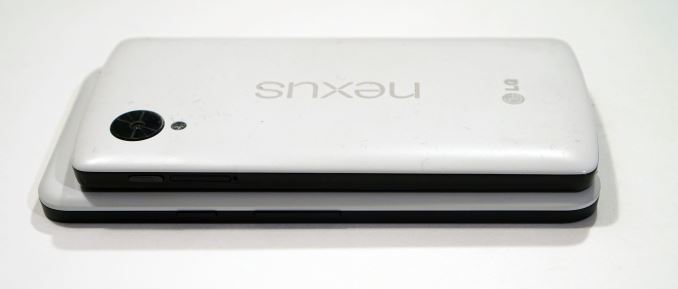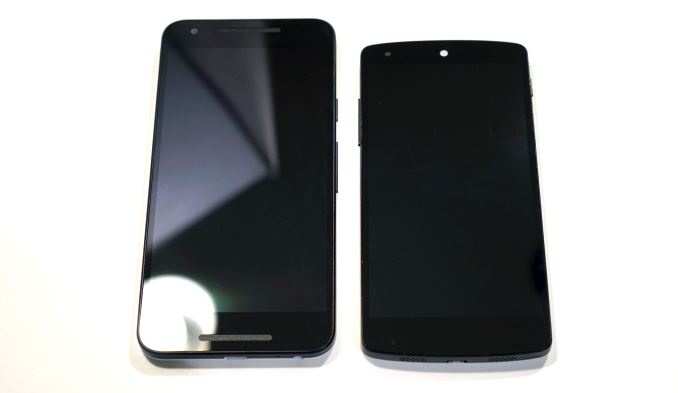The Google Nexus 5X Review
by Brandon Chester on November 9, 2015 8:00 AM EST- Posted in
- Smartphones
- LG
- Mobile
- Android 6.0
- Nexus 5X

Google's first hardware collaboration with LG brought us the Nexus 4. Like the Nexus 7, the Nexus 4 followed a philosophy of bringing as much power and quality as possible to a reasonably affordable price point. The Nexus 4 definitely wasn't a perfect phone, but it was certainly good relative to its price, and it showed that a phone can still be good even if it doesn't cost $600. About one year later Google and LG collaborated again to bring us the Nexus 5, a device which I and many other users fondly remember as an affordable phone that actually brought many of the specifications you would expect to see in a device that was priced significantly higher.
While I'm sure many hoped that 2014 would bring the next iteration of an LG Nexus device, it wasn't meant to be. Instead we got the Nexus 6 made by Motorola, which didn't really follow the pricing philosophy of the LG Nexus devices, and wasn't very competitive with devices like the Galaxy Note 4 despite its equivalent cost. At that point the future of affordable Nexus devices was unclear, and I wasn't even sure if we'd see a true successor to the Nexus 5. Fortunately, this year is the year that LG returns to bring us the next iteration of their Nexus phones, with the new device appropriately being named the Nexus 5X. With two years of hardware advancements between releases the expectations are high for this new phone, and you can check out its specs below.
| Google Nexus 5 | Google Nexus 5X | |
| SoC | Qualcomm Snapdragon 800 (MSM8974) 4 x Krait 400 @ 2.26GHz |
Qualcomm Snapdragon 808 (MSM8992) 4 x Cortex A53 @ 1.44GHz 2 x Cortex A57 @ 1.82GHz |
| GPU | Adreno 330 @ 450MHz | Adreno 418 @ 600MHz |
| RAM | 2GB LPDDR3 | |
| NAND | 16/32GB | |
| Display | 4.95" 1920x1080 IPS LCD | 5.2" 1920x1080 IPS LCD |
| Dimensions | 137.84 x 69.17 x 8.59mm, 130g | 147.0 x 72.6 x 7.9 mm, 136g |
| Camera | 8MP Rear-Facing, f/2.4, 1.4 μm 1.2MP Front-Facing, F/2.2 |
12.3MP Rear-Facing, f/2.0, 1.55 μm 5MP Front-Facing, F/2.0, 1.4 μm |
| Battery | 2300 mAh | 2700 mAh |
| Launch OS | Android 4.4 KitKat | Android 6.0 Marshmallow |
| Cellular Connectivity | 2G / 3G / 4G LTE (Qualcomm MDM9x25 UE Category 4 LTE) | 2G / 3G / 4G LTE (Qualcomm X10 LTE) |
| Other Connectivity | 1x1 802.11a/b/g/n/ac + BT 4.0, Micro-USB 2.0 | 2x2 802.11a/b/g/n/ac + BT 4.2, USB Type-C 2.0 |
| SIM | MicroSIM | NanoSIM |
| Launch Price | $349 (16GB) | $379 (16GB) |
Based on the specs you see on paper the Nexus 5X appears to represent an improvement over the Nexus 5 in every respect. Of course, it would be shocking if the successor to a two year old device didn't improve on it in every way, but we've actually seen some flagship Android phones regressing this year so such a scenario wouldn't be far removed from reality. The SoC moves from Snapdragon 800 to 808, but both the RAM and the internal storage remain the same. The display is slightly bigger, and with that comes a larger chassis and battery. The cameras receive significant upgrades, and I'll be talking about that in much more depth later in the review. Finally, both LTE and WiFi speeds receive a boost, and the starting price does jump a bit to $379 from the Nexus 5's $349.
Design
One can't really discuss the design of the Nexus 5X without comparing it to the Nexus 5. Both devices are made by LG, and when looking at the two phones one can clearly see that they use similar materials and share visual characteristics. However, the body of the Nexus 5X definitely diverges from the Nexus 5 in a number of ways, and I think the changes ultimately make for a more refined and cohesive design.
From the back it's made even clearer how the design of the Nexus 5X has matured from the Nexus 5. Google has moved the camera to the center of the back, much like its position on the Nexus 6. Beneath it is a fingerprint scanner, which Google brands as Nexus Imprint, and it's something I'll be discussing later in the review. To the left of the camera is the IR laser which handles the camera's auto-focus. The camera itself definitely has a significant hump, with it being about the same thickness as the hump on the Samsung Galaxy S6. We can talk about how this means the device isn't perfectly flat on a table and won't slide through a slot with a width of exactly 7.9mm, but if the end result is a much better camera then I'm honestly fine with the trade off, even if it might be viewed as somewhat unsightly.
The most striking difference is actually a fairly subtle one, which is the curvature of the corners and edges of the phone. On the Nexus 5 the top and bottom edges were actually curved, and they changed to the flat left and right edges at fairly sharp corners. On the Nexus 5X all the edges of the phone are flat, and there's a much more consistent curve at the corners as the edges are perpendicular rather than meeting at an angle greater than 90 degrees.
Like the Nexus 5, the 5X has a noticeable seam between the back cover and the front of the phone. This is more noticeable on the dual-tone quartz and ice colored versions, because the color abruptly changes to black. Like the corners of the phone, the back cover now curves toward the edges of the chassis, rather than changing abruptly with very little curvature like the Nexus 5 did. One could argue that all of these changes actually makes the device less-than-unique, as the more angular design of the Nexus 5 allowed it to stand out. While this is definitely true to an extent, the phone is still clearly a Nexus device, and you wouldn't confuse it with an iPhone or a Samsung Phone, or really even an LG-branded phone.
A small detail that's worth mentioning is a change in the volume and power buttons. Unlike the Nexus 5 they're now all on the right side. When I first got a device that used this arrangement it definitely took time to get used to, but now I don't really have any qualms with it. What is worth noting is that the power button doesn't have the etched texture that the one on the Nexus 6 did, but Google has spaced the buttons out an appropriate amount to ensure that you can tell whether you're touching the volume rocker or the power button. The material of the buttons has been changed though. The Nexus 5 used ceramic buttons that were much sharper and more slippery than the rest of the chassis, but on the 5X the buttons are made of the same plastic as the sides of the phone. I personally thought the ceramic buttons actually just made it harder to feel which side of the volume rocker you were on, and I have no complaints about the change on the 5X.
The front of the device can be a bit deceiving. On the top you have a speaker grille, the front-facing camera to the left of it, and an ambient light sensor. Below the display you have another speaker grille. However, the Nexus 5X does not have stereo speakers, and the top portion simply acts as the earpiece, while the bottom is the speaker used when playing general audio. The speaker itself is also pretty poor quality, with pretty obvious distortion and a generally muffled output. I was really surprised to find that it sounds worse than an iPhone 5s even when the 5s is at a higher volume, especially because I hardly hold the iPhone's downward-facing mono speaker in high regard. The fact that the speaker is front-facing definitely prevents it from being covered when you hold the phone, but my admittedly highly subjective evaluation is that the speaker quality hasn't really improved from the Nexus 5.
The last thing I wanted to comment on is the overall size of the device. Google has certainly slimmed down the body, but the larger display necessitates a wider and taller chassis. While the increases don't seem like much, they're enough to put the Nexus 5X a bit outside my comfort range. It's worth noting that I have a great amount of trouble handing large phones, while for many users the increase in size going from the Nexus 5 to the 5X may be no problem at all. For me specifically, I definitely find the Nexus 5 easier to handle. That being said, if I could transplant the Nexus 5X's internals into the Nexus 5 I wouldn't do so, because while the 5X may be a bit too big for my tastes, the ergonomics are greatly improved and that definitely contributes to a better overall feel in the hand.
For $379, the Nexus 5X gives you a solid plastic build without any flex, and that's all I really expected and wanted from a successor to the Nexus 5. For users who want a more premium-feeling device the Nexus 6P is certainly an option, but you'll obviously end up paying more for it, and I think the price has always been the most attractive aspect of the LG Nexus smartphones.













197 Comments
View All Comments
zeeBomb - Monday, November 9, 2015 - link
Same! I'm kinda in that position as well. Maybe a Z5 premium review would be cool too.Bob Todd - Monday, November 9, 2015 - link
As someone with 3 OnePlus Ones in his household, I'd tell you to run like hell toward the Nexus. The software situation is kind of a disaster for OnePlus. Fun bugs like this one where your phone won't really work as a phone for lots of users in VoLTE markets (no cellular when connected to WiFi) that go unfixed for months on end.https://jira.cyanogenmod.org/plugins/servlet/mobil...
The issue affects all 5.x radios so OxygenOS is impacted too. Then there's crap like them not fixing the Google Play Services battery drain bug in other patches even though it was a 10 minute fix in framework-res. It wasn't hard to ignore my invite for the OnePlus Two.
yankeeDDL - Monday, November 9, 2015 - link
I owe a Nexus4 and a Nexus5. Both in service and without an issue for 3 and 2 years respectively.The Nexus5 battery is starting to show signs of aging (I do still get 1 full day without charging if I limit the use, but I need to watch it).
I decided to buy a new one, but the thought of getting a new, better phone, is appealing. I owe the N5 32GB. It baffles me how there are still phones around with 8/16GB, as 32GB feels definitely tight. I guess it depends on the use one does of it, but my photos folder easily goes to 6~8GB in few weeks. Add to this 10GB of music, and there's little space for videos, games and what not. So the OnePlus X with a nice 128GB SD card sees extremely attractive, especially at that price point, using an 801 which does not overheat and does not drain the battery, and a decent size screen.
If it was a Nexus, I would not think twice. But it isn't, hence I looked forward to the N5X.
Problems: only 32GB and in Europe, it is priced at 529eur. That's 570usd. Seriously? Unfortunately, yes. The OnePlus X is nearly half of it (supposedly) and it has an SD card and a larger battery and a slightly smaller screen (a plus, in my opinion). The camera will likely not be up to that of the N5X, but still, I have a real camera when I want to take "nice" photos. To "capture the moment", I'm OK with the N5 so, I suppose, I'd be OK with the One+X.
Thanks for the feedback on One+: I do have some colleagues who have it and they did not seem t have any major problem.
UtilityMax - Monday, November 9, 2015 - link
My OnePlus One has been working great, though I have to say I never bothered to upgrade from the original ROM it shipped with some time in March.UtilityMax - Monday, November 9, 2015 - link
Based on reviews I have seen, OnePlus X suffers from the same shorter (not 5X though) battery life, heat and throttle issues as any other device using the current crop of the 64-bit Snapdargon SoCs. I have heard from a bunch of people already that they'd rather hang onto their old phones than buy the ones with the current 64-bit Snapdragon SoCs. I have one OnePlus One phone in the family, and I have to agree with them. The One is still a fantastic phone, and you can buy the 64GB version for $300 in the USA, no invites necessary.If you do want to buy one of those two, OnePlus X seems like a nice deal on paper, in the sense that all specs look slightly better.
UtilityMax - Monday, November 9, 2015 - link
Err.. sorry, I was talking about OnePlus 2 above. The OnePlus X is an excellent smart phone, but unfortunately it lacks the bands for optimal LTE service in the USA.DukeN - Monday, November 9, 2015 - link
Good job as always not giving two fucks about non-Apple devices Anandtech.Apple devices - reviews on the first day of release/reveal.
Anything else - we'll get around to it (This is like five weeks after the first reveal). And uh, maybe should have reviewed the 6P which is probably the best handset around?
No wonder this place is in the toilet relative to a few years back.
Brandon Chester - Monday, November 9, 2015 - link
The iPhone 6s was released on Sept 25, our review went up on Nov 2. The Nexus 5X was released on Sept 29, and this review has gone up on Nov 9. Accounting for the fact that we don't publish on weekends the gap was the same. I don't see how we give preference to Apple devices at all.Furthermore, I received the 5X well after other publications did, and Google didn't send a 6P along with it. We just sourced one from Huawei and so that review will take some time to do properly. Google's lack of organization in getting press hardware and software in a timely manner is why, for example, I can have an iOS review done for launch day but not an Android Marshmallow one.
Also, if you're going talk about things a few years back I suggest you look at how long the HTC One M7 review took. Doing things right takes time, and there are lots of other places to get a 24 hour review.
trekinator - Monday, November 9, 2015 - link
Thanks Brandon. Most of us appreciate the time it takes to do things right.bw13121 - Monday, November 9, 2015 - link
I'll second that. Fantastic quality and in depth review. There are those of us who do appreciate the quality and technical depth of your reviews, as most reviews are that light on detail they are useless!